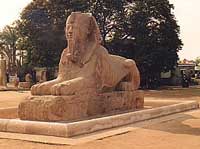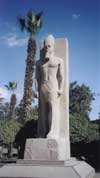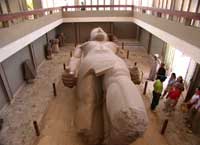|
MEMPHIS
 Memphis lies 24 km southwest of Cairo in Mit Rahina. The city’s
foundation is attributed to Menes (known also as Narmer), the
King who united Upper and Lower Egypt and launched the I Dynasty
around 3100 BC. At that time Memphis was sited at the Apex of
the Delta and thus controlled overland and river communications.
If not the earliest city on earth, it was certainly the imperial
one. Memphis lies 24 km southwest of Cairo in Mit Rahina. The city’s
foundation is attributed to Menes (known also as Narmer), the
King who united Upper and Lower Egypt and launched the I Dynasty
around 3100 BC. At that time Memphis was sited at the Apex of
the Delta and thus controlled overland and river communications.
If not the earliest city on earth, it was certainly the imperial
one.
Memphis is the oldest capital of Egypt, it was Egypt’s capital
throughout the Old Kingdom, regained its role after the anarchic
Intermediate Period and was never overshadowed by the parvenu
seat of the XII Dynasty. Even after Thebes became capital of the
New Kingdom, Memphis still held sway over Lower Egypt and
remained the nation’s city until the Ptolemaic era.
 There is little left of the city today. Originally, the city had
many fine temples, palaces and gardens. It must have been huge,
judging from the size of its necropolises which extend for some
19 miles along the west bank of the Nile that included Dahshur,
Sakkara, Abusir, Zawyet el-Aryan, Giza and Abu Rawash. There is little left of the city today. Originally, the city had
many fine temples, palaces and gardens. It must have been huge,
judging from the size of its necropolises which extend for some
19 miles along the west bank of the Nile that included Dahshur,
Sakkara, Abusir, Zawyet el-Aryan, Giza and Abu Rawash.
But today, other than the scattered ruins, most of the city is
gone, or lies beneath cultivated fields, Nile silt and local
villages. What we do know of Memphis comes to us from its
necropolises, mentioned above, text and papyrus from other parts
of Egypt and Herodotus, who visited the city. The fraction we
can see of Memphis today is located principally around the small
village of Mit Rahina. Ptah was the principle pagan god
worshipped here.
 Nowadays, the leftover statues and steles are: Nowadays, the leftover statues and steles are:
• A 13 meters long and 120 tons weighing limestone colossal
statue of Ramses II, which is now exhibited in The Egyptian
Museum and which is the most beautiful representation of Ramsis
II.
• An 80 tons weighing mightily impressive giant alabaster sphinx
of King Thutmosis III.
• Several alabaster embalming slabs, where the holy Apis bulls
were mummified before burial in the Serapeum at Saqqara |